A Hyperactive Form of unc-13 Enhances Ca2+ Sensitivity and Synaptic Vesicle Release Probability in C. elegans
- PMID: 31509756
- PMCID: PMC6779330
- DOI: 10.1016/j.celrep.2019.08.018
A Hyperactive Form of unc-13 Enhances Ca2+ Sensitivity and Synaptic Vesicle Release Probability in C. elegans
Abstract
Munc13 proteins play several roles in regulating short-term synaptic plasticity. However, the underlying molecular mechanisms remain largely unclear. Here we report that C. elegans UNC-13L, a Munc13-1 ortholog, has three domains that inhibit synaptic vesicle (SV) exocytosis. These include the X (sequence between C2A and C1), C1, and C2B domains. Deleting all three inhibitory domains produces a hyperactive UNC-13 (sUNC-13) that exhibits dramatically increased neurotransmitter release, Ca2+ sensitivity of release, and release probability. The vesicular pool in unc-13 mutants rescued by sUNC-13 exhibits a faster synaptic recovery and replenishment rate, demonstrating an important role of sUNC-13 in regulating synaptic plasticity. Analysis of double mutants suggests that sUNC-13 enhances tonic release by increasing the open probability of UNC-64/syntaxin-1A, whereas its effects on evoked release appear to be mediated by additional functions, presumably by further regulating the activity of the assembled soluble N-ethylmaleimide-sensitive factor activating protein receptor (SNARE) complex.
Keywords: Ca(2+) sensitivity; evoked release; synaptic depression; synaptic transmission; syntaxin-1A; tonic release; unc-13.
Copyright © 2019 The Author(s). Published by Elsevier Inc. All rights reserved.
Conflict of interest statement
DECLARATION OF INTERESTS
The authors declare no competing interests.
Figures
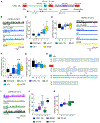
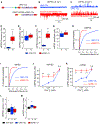
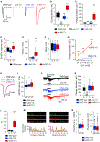
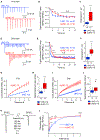
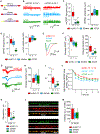
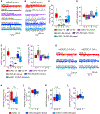
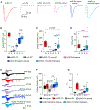
Similar articles
-
Mechanisms that regulate the C1-C2B mutual inhibition control functional switch of UNC-13.Elife. 2025 Apr 11;14:RP105199. doi: 10.7554/eLife.105199. Elife. 2025. PMID: 40215098 Free PMC article.
-
Heterodimerization of UNC-13/RIM regulates synaptic vesicle release probability but not priming in C. elegans.Elife. 2019 Feb 25;8:e40585. doi: 10.7554/eLife.40585. Elife. 2019. PMID: 30802206 Free PMC article.
-
Open syntaxin overcomes exocytosis defects of diverse mutants in C. elegans.Nat Commun. 2020 Nov 2;11(1):5516. doi: 10.1038/s41467-020-19178-x. Nat Commun. 2020. PMID: 33139696 Free PMC article.
-
The synaptic vesicle cycle: exocytosis and endocytosis in Drosophila and C. elegans.Curr Opin Neurobiol. 2002 Oct;12(5):499-507. doi: 10.1016/s0959-4388(02)00360-4. Curr Opin Neurobiol. 2002. PMID: 12367628 Review.
-
Unc13 Aligns SNAREs and Superprimes Synaptic Vesicles.Neuron. 2017 Aug 2;95(3):473-475. doi: 10.1016/j.neuron.2017.07.017. Neuron. 2017. PMID: 28772115 Review.
Cited by
-
Sexually Dimorphic Neurotransmitter Release at the Neuromuscular Junction in Adult Caenorhabditis elegans.Front Mol Neurosci. 2022 Jan 31;14:780396. doi: 10.3389/fnmol.2021.780396. eCollection 2021. Front Mol Neurosci. 2022. PMID: 35173578 Free PMC article.
-
A specific negatively charged sequence confers intramolecular regulation on Munc13-1 function in synaptic exocytosis.Proc Natl Acad Sci U S A. 2025 Jun 17;122(24):e2508915122. doi: 10.1073/pnas.2508915122. Epub 2025 Jun 9. Proc Natl Acad Sci U S A. 2025. PMID: 40489622
-
A unique C2 domain at the C terminus of Munc13 promotes synaptic vesicle priming.Proc Natl Acad Sci U S A. 2021 Mar 16;118(11):e2016276118. doi: 10.1073/pnas.2016276118. Proc Natl Acad Sci U S A. 2021. PMID: 33836576 Free PMC article.
-
Protocols for electrophysiological recordings and electron microscopy at C. elegans neuromuscular junction.STAR Protoc. 2021 Aug 13;2(3):100749. doi: 10.1016/j.xpro.2021.100749. eCollection 2021 Sep 17. STAR Protoc. 2021. PMID: 34430921 Free PMC article.
-
Different priming states of synaptic vesicles underlie distinct release probabilities at hippocampal excitatory synapses.Neuron. 2022 Dec 21;110(24):4144-4161.e7. doi: 10.1016/j.neuron.2022.09.035. Epub 2022 Oct 18. Neuron. 2022. PMID: 36261033 Free PMC article.
References
-
- Aravamudan B, Fergestad T, Davis WS, Rodesch CK, and Broadie K (1999). Drosophila UNC-13 is essential for synaptic transmission. Nat. Neurosci 2, 965–971. - PubMed
-
- Augustin I, Rosenmund C, Südhof TC, and Brose N (1999). Munc13-1 is essential for fusion competence of glutamatergic synaptic vesicles. Nature 400, 457–461. - PubMed
-
- Borst JG, and Sakmann B (1996). Calcium influx and transmitter release in a fast CNS synapse. Nature 383, 431–434. - PubMed
Publication types
MeSH terms
Substances
Grants and funding
LinkOut - more resources
Full Text Sources
Miscellaneous

